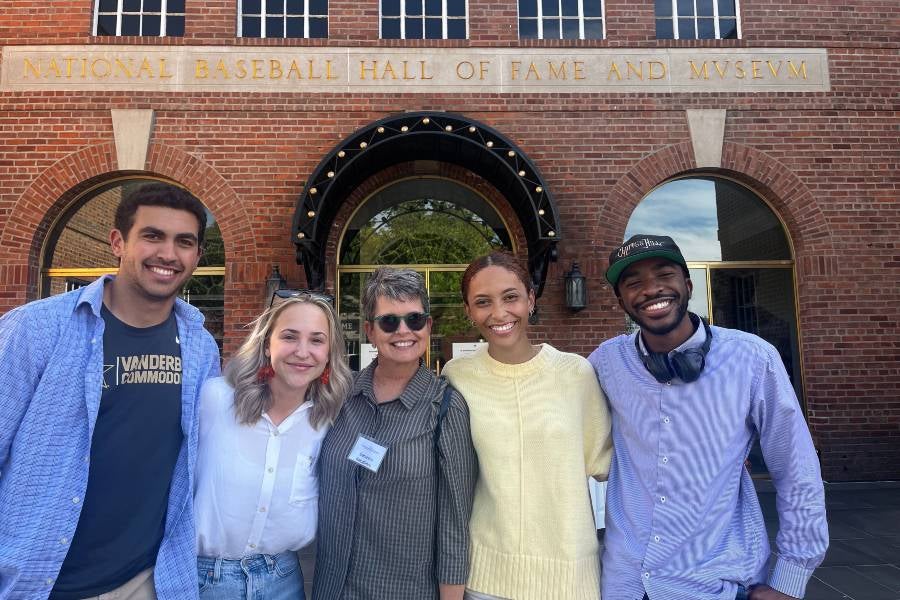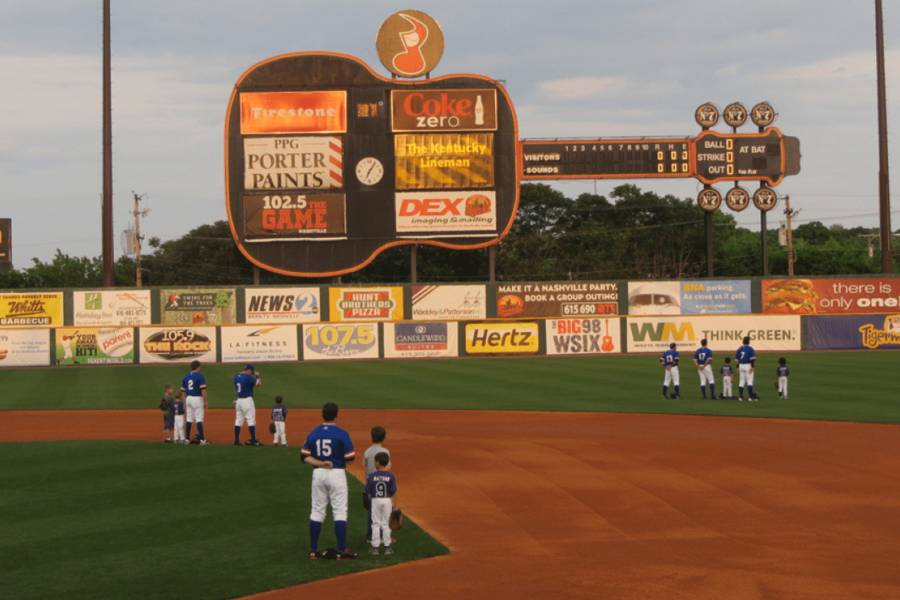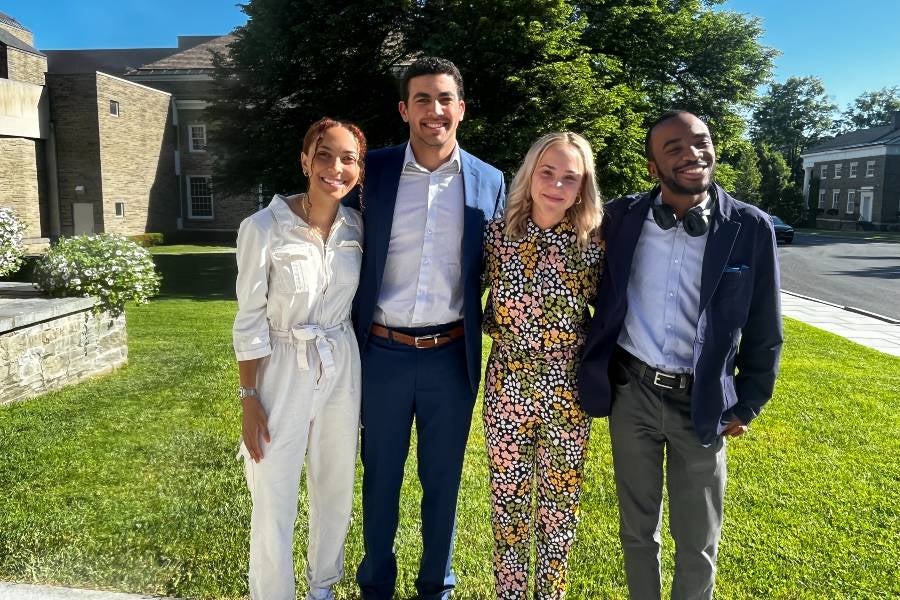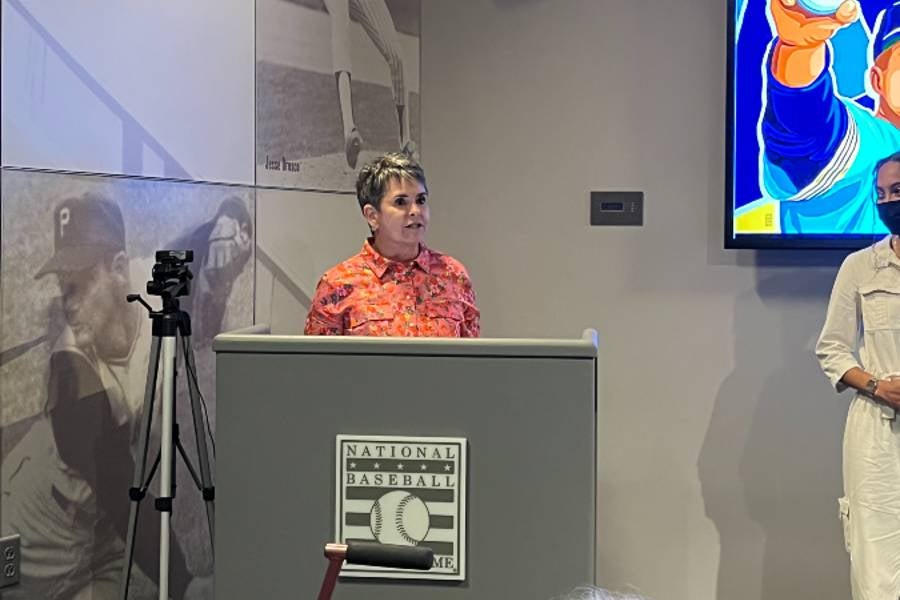Student documentary on famous Nashville Sounds scoreboard selected for Cooperstown
Kim Chaudoin |

It is the dream of many a major league baseball player to “make it to Cooperstown” as an inductee in the famed Baseball Hall of Fame in Cooperstown, New York.
A group of Lipscomb School of Communication students made it to Cooperstown this summer — not because of their baseball talents, but because of their video and storytelling skills.
This spring Demetria Kalodimos, professional-in-residence in the School of Communication and veteran journalist, submitted a proposal to present at the 33rd Cooperstown Symposium on Baseball and American Culture at the National Baseball Hall of Fame and Museum in Cooperstown, New York, June 1-3. Her proposal was to present a student-produced documentary about the Nashville Sounds’ iconic guitar-shaped scoreboard. After a highly competitive process, Kalodimos’s proposal was accepted.
“It was quite an honor to be selected, and an excellent opportunity for our students,” said Kalodimos. She quickly assembled a student production team of about a dozen students who volunteered their time to the project and got to work.
The scoreboard was located at the Triple-A minor league Nashville Sounds’ former longtime home at Greer Stadium at Fourth Avenue South and Chestnut Street in Nashville. The stadium opened in 1978 as the home of the Sounds and the scoreboard remained a favorite site at games until the team moved to First Horizon Park in Germantown in 2015. Demolition of Greer Stadium took place in 2019.
Chicago-based real estate developer AJ Capital Partners bought the scoreboard in 2019 at auction for $54,815. The company has incorporated the scoreboard into the design of the city’s new Nashville Warehouse Company site, just blocks from its original home.

The famed guitar-shaped scoreboard at the Nashville Sounds former home at Herschel Greer Stadium.
Kalodimos and team quickly developed a plan for producing the documentary including interviewing sources, finding historical visuals of the scoreboard, capturing game footage and weaving the story together. The primary student production crew included seniors Shawna Mann, Spencer Barnabee, Emma Shanahan and May graduate Kahwit Tela. The group had about two months to produce a documentary about the beloved Nashville icon.
“After a few group meetings, the students were tasked with reaching out to potential interviewees. We settled on primary sit downs with local baseball historian Skip Nipper, founder and former Sounds president Larry Schmittou and Cy Young Award winning pitcher R.A. Dickey,” explained Kalodimos. “We didn’t have much time to produce this piece.”
Students learned about the logistics involved in producing a documentary such as securing clearances for locations and interview subjects, required forms and sending thank you notes to those who were a part of the project. “It’s always eye-opening when you embark on a project like this for the first time,” said Kalodimos. “The editing piece is also a learning experience as you have to invest about 10 hours of editing and production time per one minute of the final product. I really believe they learned something.”
Kalodimos enlisted the assistance of Jeff Wiltgen, former chief photographer at KARE-TV in Minneapolis who recently moved to Nashville, and Zina Bauman, an Emmy award winning videographer/editor and owner of Melody & Light Pictures in Nashville, who both volunteered their professional expertise and time to help students with the project. Wiltgen coached the students on the basics of shooting a baseball game and provided guidance on lighting and framing of shots for the interview segments. Bauman assisted with another shot. Student Ashlyn Liddle used her artistic skills to animate the project’s title.

Communication students Shawna Mann, Spencer Barnabee, Emma Shanahan and May graduate Kahwit Tela presented a documentary about the fames Nashville Sounds' guitar scoreboard.
The result? An 18-minute documentary, The Grand Ole Guitar. It was screened the final morning of the conference as part of a session on Baseball on campus and in the community.
Mann, Barnabee, Shanahan and Tela made the trek to New York with Kalodimos to make the presentation. The students introduced the piece before an enthusiastic crowd in the Baseball Hall of Fame's Bullpen Theater and they fielded questions after the screening.
“Lipscomb hit it out of the park at the 33rd Cooperstown Symposium on Baseball and American Culture,” Kalodimos said proudly. “The academics and other presenters at the symposium were amazed at what we accomplished in such a short period of time. We got rave reviews and lots of encouragement to continue submitting these sorts of short docs in the future.”
“I was exceptionally proud of the student’s professionalism and poise,” she continued. “It was a great bonding experience for the students and a memorable journey.”
Barnabee, a sports media major from Nashville, said his biggest takeaway from the production process was the need for the attention to detail.
“From reaching out and communicating with the people you want to interview to setting everything up quickly and being able to get shots on the fly, detail was important. Professional cameraman Jeff Wiltgen helped us at multiple shoots and gave us a lot of great tips on how to frame shots and how to be thinking ahead about what you want for the piece,” said Barnabee. “The more work you do in pre production, the less you’ll have to do during production and post production, which was something I sometimes had to learn the hard way. But trust me it’s true.”

Demetria Kalodimos presents at the National Baseball Hall of Fame and Museum in Cooperstown, New York last month.
The presentation aspect of the project was also a learning experience for Barnabee. He admitted that he was very nervous at the outset and as the documentary was playing, “I was thinking about a couple of shots in my head that I thought I could’ve done better.”
“But at the end of it everyone absolutely loved it and what that really taught me was, while, yes,” he continued, “you want to create good work that is professional and you can be proud of, at the end of the day your goal should just be to entertain/inform your audience and if you can do that then I think you’ve succeeded.”
But this was more than just a valuable learning experience to Barnabee, it was a gift. A lifelong baseball fan, in the fall Barnabee learned of a possible internship at the Baseball Hall of Fame this summer.
“However, I felt God telling me not to do it. I didn't know why, and maybe there are more reasons yet to be revealed to me,” said Barnabee. “At the same time, I recognized the work He was doing in me and I just wanted to trust in Him.”
Not long after Barnabee made the decision not to pursue the internship opportunity, he received an email from Kalodimos inviting him to be a part of the documentary project to be shown at the Hall of Fame.
“I had to do a double take at the email because I was like ‘no way’ is this an opportunity at the Hall of Fame,” he recalled. “So even through the confusion I had been feeling, I still ended up at Cooperstown this summer except I wasn’t there as an intern. I was there as a presenter, which is pretty cool.”
“So while, yes, this was a great experience that I learned a ton from and can put on my resume, for me this trip was an absolute gift from God,” continued Barnabee. And I’m just so happy He gave me the heart to listen.”
Kalodimos said she and the communication students are already brainstorming other topics to work on for next year.
Learn more about academic programs offered by the School of Communication.